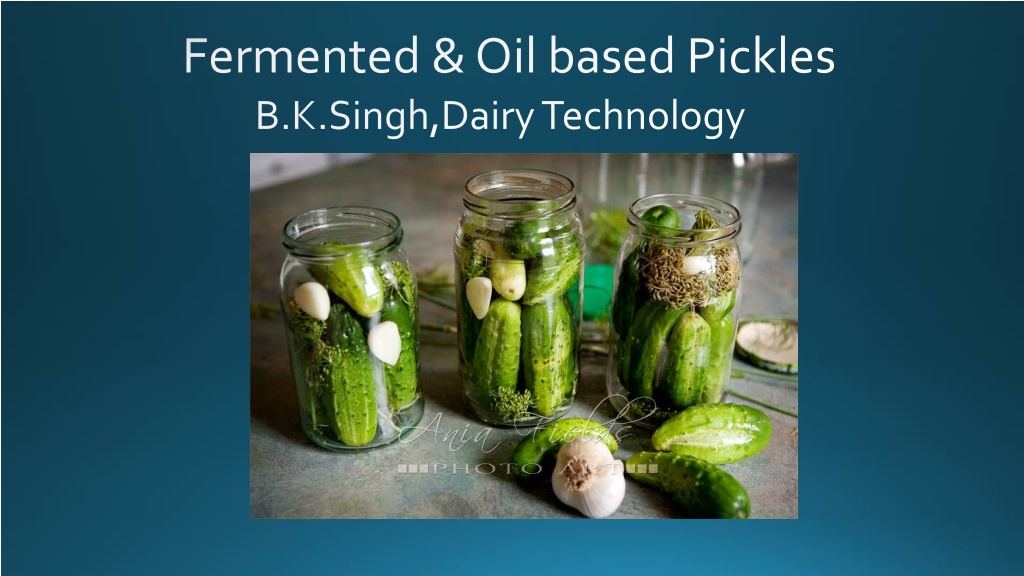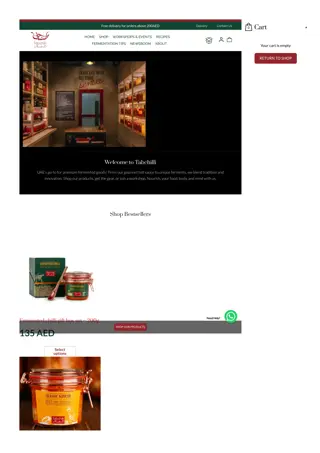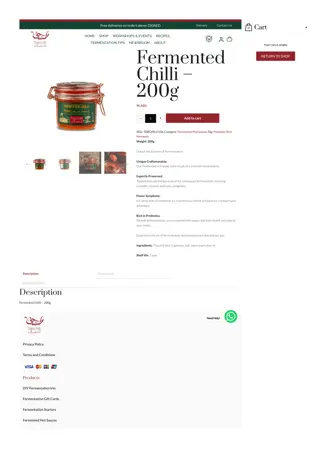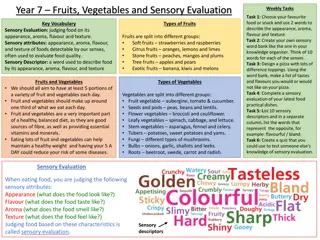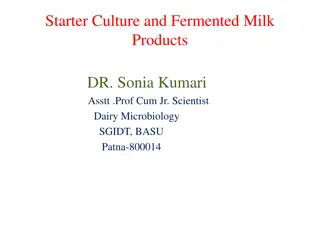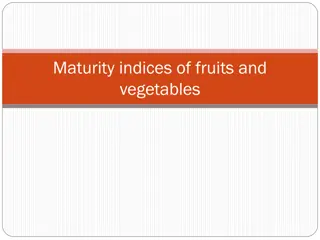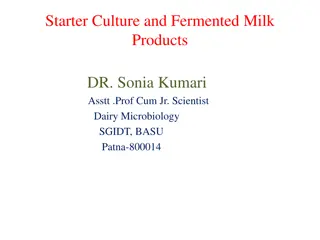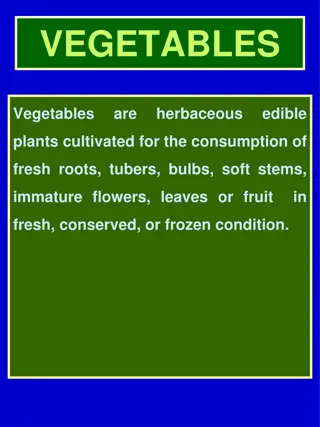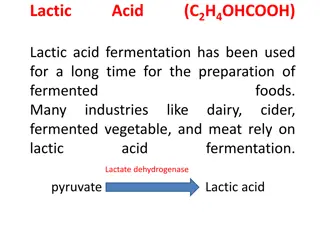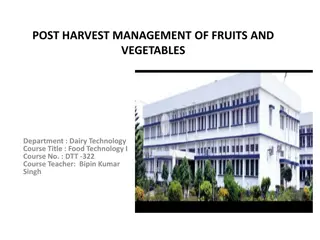Fermented Vegetables: Health Benefits and Production Process
Fermented vegetables offer a plethora of health benefits, such as aiding digestion, boosting the immune system, and potentially reducing the risk of certain diseases. Sauerkraut, a popular fermented cabbage dish, is a common example, known for its distinct sour flavor and nutritious profile. The fermentation process involves lactic acid bacteria transforming fresh vegetables into delicious and healthy products. Pickled cucumbers, another favorite, undergo varying fermentations based on salt concentrations, producing high-salt stock or low-salt dill pickles. Explore the world of fermented vegetable pickles and their positive impact on your well-being.
Download Presentation

Please find below an Image/Link to download the presentation.
The content on the website is provided AS IS for your information and personal use only. It may not be sold, licensed, or shared on other websites without obtaining consent from the author. Download presentation by click this link. If you encounter any issues during the download, it is possible that the publisher has removed the file from their server.
E N D
Presentation Transcript
Fermented & Oil based Pickles B.K.Singh,DairyTechnology
Fermented Pickles Fermented foods are foods that have been subjected to the action of microorganisms or enzymes, in order to bring about desirable changes such as improved flavour, etc. The fermentation of vegetables is a complex network of interactive microbiological, biochemical, enzymatic and physico-chemical reactions. Lactic acid fermentation is a valuable tool for the production of a wide range of vegetable products. A large number of vegetables are preserved bylactic acid fermentation around theworld.
Fermented Pickles Fermented vegetables pickles available in the market, Fermented cabbage (sauerkraut), Cucumber pickle and Olive pickles
Sauerkraut Sauerkraut is one of the most consumed fermented vegetables in central and southern Europe and in the United States. Sauerkraut is the product resulting from the natural lactic acid fermentation of shredded fresh cabbage to which salt is added at a concentration of 2.25 2.5%. A number of microorganisms play a key role in the transformation of fresh shredded cabbage into the fermented product called sauerkraut. Sauerkraut is finely cut raw cabbage that has been fermented by various lactic acid bacteria. It has a long shelf life and a distinctive sour flavor, both of which result from the lactic acid formed when the bacteria ferment the sugars in the cabbage leaves.
Flow chart for the production of sauerkraut
Health Benefits Sauerkraut is very nutritious Improves your digestion Boosts your immune system May help you lose weight Helps reduce stress and maintain brain health May reduce the risk of certain cancers May promote heart health Contributes to stronger bones
Pickled Cucumber The fermentation of cucumbers varies according to the salt concentration used, and two quite different products can be produced, namely high-salt stock (8 10% increasing to 15%) and low-salt dill pickles (3 5% salt containing dill and spices). Usually, the salt solution is poured onto the cucumbers in tanks and then fermentation is allowed to proceed, if necessary, glucose is added to stimulate activity. Fermentation takes place at 18 20 C and yields lactic acid, CO2, some volatile acids, ethanol and small amounts of various aroma substances.
Types Brined pickles Bread-and-butter Gherkin Kosher dill Hungarian Polish and German Lime Kool-Aid pickles
Nutrition Like pickled vegetables such as sauerkraut, sour pickled cucumbers (technically a fruit) are low in calories. They also contain a moderate amount of vitamin K, specifically in the form of K1. 30-gram sour pickled cucumber offers 12 16 g, or approximately 15 20%, of the Recommended Daily Allowance of vitamin K. It also offers 3 kilocalories (13 kJ), most of which come from carbohydrate. However, most sour pickled cucumbers are also high in sodium; one pickled cucumber can contain 350 500mg, or 15 20% of theAmerican recommended daily limit of 2400mg. Sweet pickled cucumbers, including bread-and-butter pickles, are higher in calories due to their sugar content; a similar 30-gram portion may contain 20 to 30 kilocalories (84 to 126 kJ). Sweet pickled cucumbers also tend to contain significantly less sodium than sour pickles. Pickles are being researched for their ability to act as vegetables with a high probiotic content. Probiotics are typically but lactobacilli species such as L. plantarum and L. brevis have been shown to add to the nutritional valueof pickles. associated with dairy products,
Olive Pickle Olives (Olea europaea) are produced in great amounts in the Mediterranean area, California, South America and Australia among others. This fruit is processed for oil production (about 85%) and for table use (about 15%). Green olives are brined and fermented in a manner similar to cucumbers. Spanish, Greek and Sicilian are the most important types of fermented olives. Before brining, green olives are treated with a 1.25 to 2 % lye solution, depending on the type of olives usually at 21to 25 C for 4 to 7 h.
Process Steps Wash the olives well in water and place them in a big bowl which can hold all the olives and add water to cover them. Extract the bitterness from the olives by soaking them in fresh water for a week Pour out the soakingwater after seven days of soaking. Put in the garlic, hot peppers, lemon slices, coriander or fennel seeds and bay leaves into the jar. Pour the salt solution into the jar until it covers the olives. Pour a bit of olive oil to create a thin protective layer on top. Close the jar and place it in a cool, darkplace. The olives will be ready for eating after 2 weeks to a month, if they were split, or four monthsif they are intact
Oil Based Pickles Oil-based pickles containing one or more edible oils are highly popular in India. Mango, lime, cauliflower and turnip pickles are the most important oil pickles. Mango pickle is largely sold pickle in the country followed by cauliflower, onion, turnip and lime pickles. Cauliflower pickle is highly popular in Northern parts of India. For preparing the oil-based pickles, fruits or vegetables should be completely immersed in the edible oil. Oil pickles are generally highly spiced. The technology for the preparation of some of these pickles is given in this lesson.
Mango Pickle The method of preparation of oil-based mango pickles varies in different parts of the country. The avakai pickle of Andhra Pradesh is a well known mango pickle in oil. It is very pungent and hot to taste. In north India, rapeseed /mustard oil is commonly used. But in south India, gingellyor sesame oil or groundnutoil are preferred. Hygienically prepared mango pickle should have a shelf life of about 1 to 2years at room temperature. India, being the largest producer of mangoes, has great scope for export of mango pickles. Because of regional variations in taste, thereare numerousrecipe combinations of mango pickle.
Flow Diagram Selection of Mango Washing with water Peeling Cutting in Slices Mixing with salt Addition of spices Addition of sugar, acetic acid Filling in Glass Jar Covering with edible Oil Fermentation Mango Pickle
